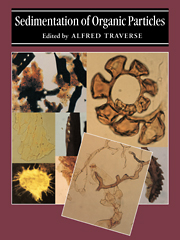Book contents
- Frontmatter
- Contents
- Editor's preface
- List of contributors
- I Introduction
- II Studies of palynosedimentation in modern environments
- III Reconstruction of late Cenozoic vegetation and sedimentary environments from palynological data
- IV Application of data on palynosedimentation to solution of geological problems
- 16 Palynology of sedimentary cycles
- 17 Particulate organic matter, maceral facies models, and applications to sequence stratigraphy
- 18 Association of palynomorphs and palynodebris with depositional environments: quantitative approaches
- 19 A quantitative approach to Triassic palynology: the Lettenkeuper of the Germanic Basin as an example
- 20 Palynomorph concentration in studies of Paleogene nonmarine depositional environments of Wyoming
- 21 Multivariate analyses of palynomorph data as a key to depositional environments of Upper Cretaceous and Paleogene coal-bearing rocks of the western United States
- 22 Relationships between depositional environments and changes in palynofloras across the K/T boundary interval
- 23 Sedimentation of palynomorphs in rocks of pre-Devonian age
- V Appendix
- Index
17 - Particulate organic matter, maceral facies models, and applications to sequence stratigraphy
Published online by Cambridge University Press: 06 January 2010
- Frontmatter
- Contents
- Editor's preface
- List of contributors
- I Introduction
- II Studies of palynosedimentation in modern environments
- III Reconstruction of late Cenozoic vegetation and sedimentary environments from palynological data
- IV Application of data on palynosedimentation to solution of geological problems
- 16 Palynology of sedimentary cycles
- 17 Particulate organic matter, maceral facies models, and applications to sequence stratigraphy
- 18 Association of palynomorphs and palynodebris with depositional environments: quantitative approaches
- 19 A quantitative approach to Triassic palynology: the Lettenkeuper of the Germanic Basin as an example
- 20 Palynomorph concentration in studies of Paleogene nonmarine depositional environments of Wyoming
- 21 Multivariate analyses of palynomorph data as a key to depositional environments of Upper Cretaceous and Paleogene coal-bearing rocks of the western United States
- 22 Relationships between depositional environments and changes in palynofloras across the K/T boundary interval
- 23 Sedimentation of palynomorphs in rocks of pre-Devonian age
- V Appendix
- Index
Summary
Introduction
Organic matter found dispersed in aqueous systems and in sedimentary rocks consists of organic compounds derived from both autochthonous and allochthonous sources. The form of this material ranges from wellpreserved particulate organic matter (POM or macerals) to dissolved organic matter (DOM). The total mass of this organic matter is very large, and Mclver (1967) notes that it is 500–1000 times the amount found in coal, and 10000 times the amount in all organisms living at the present time. Both Weeks (1958) and Hunt (1962) estimated the total mass to be 3.2 × 1015 metric tons.
The microscopic analysis of POM has gained widespread acceptance as a reliable means of assessing the petroleum source potential and thermal maturity of rocks in sedimentary basins. Numerous studies, using various classifications of organic matter, indicate that a relationship exists between POM and petroleum source potential (e.g., Burgess, 1974; Dow, 1977; Teichmüller & Wolf, 1977; Robert, 1981; Mukhopadhyay et al., 1985; Senftle et al., 1987). Thermal maturity measurements in the form of vitrinite reflectance and transmitted color are routine in petroleum source rock evaluation (Staplin, 1969; Bostick, 1971, 1974; Castaño & Sparks, 1974; Dow, 1977; Peters et al., 1911; Hunt, 1979; Dow & O'Connor, 1982; Saxby, 1982; Stach et al., 1982; Pearson, 1984; Tissot & Welte, 1984; Waples, 1985).
Contemporary depositional environments contain many clues to the origin of the sediments accumulating on the depositional surface. Unfortunately, rocks rarely preserve sufficient information to reconstruct accurately the original depositional environment. Information is lost principally at the sediment–water interface and during the diagenetic stage of lithogenesis.
- Type
- Chapter
- Information
- Sedimentation of Organic Particles , pp. 337 - 390Publisher: Cambridge University PressPrint publication year: 1994
- 13
- Cited by



